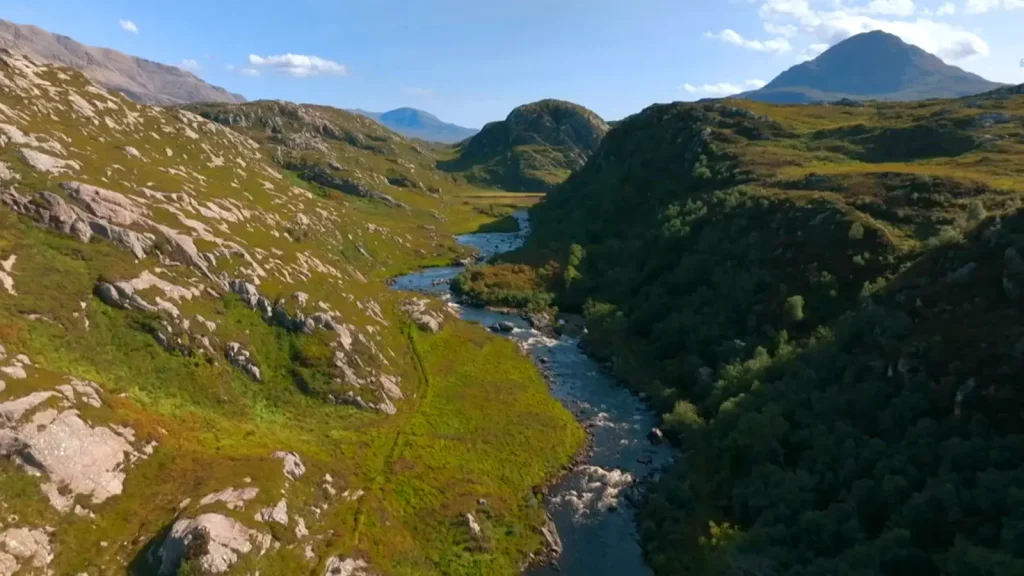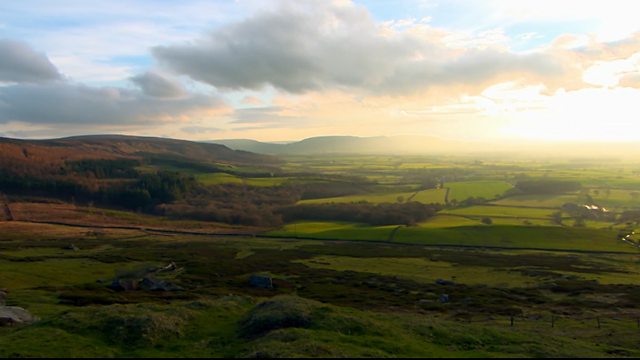
Landward episode 20 2023 – Dougie embarks on a captivating journey, steering his vessel up the historic waters of the Firth of Clyde, making his way to the picturesque town of Greenock. As he travels, he is surrounded by echoes of Scotland’s illustrious trading heritage. Greenock, once a bustling hub of commerce, holds tales of times when ships laden with goods would set sail for distant lands. As Dougie explores, he unveils the transformative story of this industrial river system, which has undergone a remarkable recovery after suffering from centuries of pollution. The narrative isn’t just about the past; it also highlights the resurgence of marine life. Dougie learns about the diverse marine species that have returned and now thrive in these cleaner waters.
Further north, Rosie finds herself amidst the rugged landscapes of Sutherland. She’s there to delve into the ambitious undertakings at the Reay Forest Estate. This sprawling expanse of land is now the focal point of a significant conservation effort, a landscape-scale initiative, specifically designed to rescue the dwindling numbers of the Atlantic salmon in the River Laxford. The mission is not only about preserving these majestic creatures but also about restoring the delicate balance of the ecosystem they call home.
Meanwhile, Shahbaz stands by the serene banks of the Clunie Water, a significant tributary feeding into the mighty River Dee. The area is abuzz with the latest ecological innovations. Shahbaz discovers how storm trees, once deemed fallen and forgotten, are now being strategically used to enhance and improve the river habitat.
These natural interventions promise a brighter future for the local aquatic life. As an added treat, Shahbaz, with his keen photographer’s eye, offers invaluable insights on capturing the perfect shot of these river landscapes. He also takes a moment to showcase and appreciate some of the most stunning viewer-submitted photographs, celebrating the beauty of nature and the art of photography.
Landward episode 20 2023
Dougie sets sail up the Firth of Clyde to Greenock to see the reminders of Scotland’s trading past. He discovers how this industrial river system is recovering from centuries of pollution, and hears about some of the marine species now in residence. Rosie is in Sutherland to visit the Reay Forest Estate, where an ambitious landscape-sized project aimed at saving Atlantic salmon in the River Laxford is under way. Meanwhile, Shahbaz is on the banks of the Clunie Water, a tributary of the River Dee, where he finds out how storm trees are being used to improve the river habitat. He also shares a few tips about photographing river landscapes and chooses his favourite viewer pictures.
Discovering the Treasures of the Historic Firth of Clyde
The Firth of Clyde holds a special place in Scotland’s heritage. This majestic seaway stretches along the west coast, carved out by glaciers long ago. For centuries, the Firth served as a critical maritime gateway connecting Scotland to international trade and migration. Today, it retains its allure as a natural treasure, though remnants of its industrial past remain.
The Firth spans a vast area over 100 miles long and 24 miles wide at its broadest point. Its shores encompass bustling cities like Glasgow and Greenock, quaint seaside towns, and stunning scenic vistas. While ferries still ply its waters, conservation efforts are helping restore the Firth’s biodiversity. Seals, porpoises, seabirds, and even whales now frequent this resurgent marine habitat.
The best way to appreciate the Firth is getting out on its waters. Visitors can take boat tours from several harbors, allowing a closer glimpse of coastal highlights. On land, cycling or driving the Firth’s perimeter unveils panoramas and seafront communities linked to its maritime heritage. Museums and historic sites like castles dot its edges, showcasing the area’s rich history and culture.
Greenock: Scotland’s Vibrant Port Town
On the Firth’s southern bank lies the colorful port town of Greenock. For centuries, busy shipyards defined Greenock as one of Scotland’s major maritime hubs. Though its shipbuilding days have passed, the waterfront still bustles with ferries, recreational marinas, and impressive Victorian-era architecture.
Greenock thrived during the 18th and 19th centuries. Wealth from colonial trade funded the construction of magnificent mansions for merchant lords. The historic Custom House and imposing Custom House Quay hint at the port’s former trading might. While heavy industries eventually declined, Greenock reinvented itself as a commuter town and electronics manufacturing center.
Visitors shouldn’t miss Greenock’s regal Esplanade, lined with Victorian buildings and monuments. The town also brims with excellent museums like the McLean Museum and the Beacon Arts Centre. Just outside town, Finlaystone Country Estate offers scenic woodland walks and grand historic architecture.
Though the intervening centuries brought much change, Greenock retains its proud spirit as an integral hub along the Firth of Clyde. Its evolving waterfront continues to connect residents and travelers to the surrounding landscapes and seascape.
Revitalizing the Clyde: Bringing Back Marine Life
The Firth of Clyde’s industrial heyday left a legacy of pollution that degraded habitats and depleted wildlife. But recent conservation efforts are helping restore areas of the Firth to their former ecological glory. Thanks to improving water quality and protected zones, seals, porpoises, seabirds, and other marine life are returning.
At one time, untreated sewage and industrial effluents fouled the Firth’s waters. Overfishing and habitat loss also impacted biodiversity. But since the 1980s, steps like modernizing sewage treatment and regulating fishing pressure allowed species to recover. New marine protected areas furnish sanctuaries for vulnerable wildlife to thrive.
Harbor seals frequent the Firth today, basking on rocky shores and sandbanks. Risso’s and bottlenose dolphins are often spotted, especially around Cumbrae. Chirping seabirds like kittiwakes and terns nest on coastal cliffs. And even occasional whale and shark sightings suggest a healthy rebound.
Community efforts like beach cleanups and seagrass restoration are expanding the Firth’s revival. Scotland’s marine conservation groups provide critical education on protecting this vital ecosystem. While work remains, the tides are turning towards a cleaner, life-filled future for the Firth.
The Reay Forest Estate: A Wild Salmon Stronghold
Tucked amid Scotland’s rugged northwest highlands lies Sutherland’s sprawling Reay Forest Estate. Encompassing 55,000 acres of Caledonian pinewood forests, lochs, and glens, the estate offers a sanctuary for wildlife. This wild realm provides vital habitat for endangered Atlantic salmon in the River Laxford.
The estate’s remote forests border Sweeping vistas over the Moine mountains to the highlands beyond. Four lochs including Loch Stack reflect the drama of the soaring landscape. Originating in Loch Stack, the River Laxford winds 20 miles through gorges and rapids before reaching the sea.
For millennia, wild Atlantic salmon have migrated up the Laxford to spawn in its tributaries. But factors like overfishing, pollution, and dams diminished their numbers. Now the estate is collaborating with conservation groups on an ambitious habitat restoration effort called the River Laxford Project.
By improving spawning sites, removing barriers, and monitoring fish stocks, the initiative aims to boost salmon numbers. Scotland’s Atlantic salmon face threats across their range, so safeguarding the Laxford offers hope. The project demonstrates that even remote rivers can be revitalized when community efforts unite to support keystone species.
Safeguarding the River Laxford’s Atlantic Salmon
The River Laxford Project centers on preserving Atlantic salmon within the river’s diverse habitats. These iconic fish have declined across Scotland, so protecting the Laxford population is critical. Salmon travel over 3,000 miles in their lifetime, navigating coastal waters and fighting upstream to spawn. Maintaining connected, healthy habitats across their range is vital to reverse the species’ declines.
On the Laxford, efforts focus on improving spawning grounds and food supplies so more salmon survive to spawn successfully. Non-native conifer plantations along the banks are being removed to allow broadleaf trees to regenerate naturally. This provides more food and shade for juvenile salmon. Workers also enhance spawning sites by adding clean gravel and boulders for fish to lay eggs in optimal conditions.
Manmade barriers like old dams have been dismantled to aid the salmon’s journey. Water quality monitoring ensures pollution remains in check. Ongoing research tracks fish numbers to gauge population trends. The estates’ protection enables salmon to migrate and breed undisturbed.
Scotland’s wild salmon populations could collapse without active human stewardship. The River Laxford Project provides a model for landscape-scale conservation that combines scientific study with habitat restoration. If such efforts keep pace with mounting threats, these iconic fish may continue their ancient seasonal cycle across Scotland’s rivers.
The Meandering Clunie Water
Nestled in Scotland’s majestic Cairngorms National Park, the moorland river Clunie Water offers a glimpse of the region’s wilderness. This meandering tributary of the storied River Dee cuts through heather meadows and Caledonian pine forests in the Dee’s upper reaches. Though lesser known than the salmon-rich Dee, the Clunie possesses its own tranquility and charm.
The Clunie Water emerges from Loch Callater, flowing 21 miles southwest where it merges into the River Dee near Braemar. In Gaelic, Clunie means ‘meadow river,’ aptly describing the stream’s path through open moorlands flanked by forests. The river alternates between calm pools and cascading rapids as it descends from the highlands.
This remote river remains relatively unspoiled due to the park’s protections. A hiking trail follows the Clunie for several miles, offering walkers a close-up view of its beauty. Here, dippers and rare black throated divers inhabit the river’s stony shallows. At night, pine martens prowl the banks under the northern constellations. For anglers, the Clunie also yields brown trout in its sparkling currents.
As part of Scotland’s ancient supportive network of rivers, burns, and lochs, the Clunie Water epitomizes the country’s wild soul. This modest river plays an integral role in sustaining the Dee’s biodiversity. Safeguarding the Clunie means preserving an untamed sanctuary at the heart of the highlands.
Storm Trees: Riparian Guardians
Lining riverbanks across Scotland, “storm trees” serve as natural guardians against erosion. These trees help reinforce vulnerable shorelines, protecting water quality and fish stocks in the process. Targeted conservation programs are now working to restore storm trees along rivers like the Clunie Water where they’ve declined.
Storm trees are large old hardwoods like oaks, willows, and Scots pines situated on riverbanks. Their extensive root systems grip the banks, buffering against current and flood impacts. But historical deforestation removed many storm trees, leaving riversides susceptible to erosion during storms.
Erosion muddies waters, smothering fish spawning beds. Undercut banks collapse, wiping out aquatic life. Restoring storm trees provides natural stabilization. Their trailing roots form aquatic shelters while fallen trees in rivers create riffles that aerate water and provide cover.
On the Clunie Water, conservationists now select seemingly precarious trees beside eroding banks to preserve rather than remove. Wire cages protect saplings until established. Storm tree interventions along rivers don’t interfere with natural channel dynamics. They only give at-risk zones an added defense.
Like the rivers they guard, storm trees have intrinsic value too as wildlife havens. From fungi and lichens to cavity nesting birds, storm trees enrich biodiversity. Their presence along rivers symbolizes the balance between hardy yet fragile life cradled by the flowing waters.
Capturing Rivers’ Shifting Moods
Scotland’s rivers showcase nature’s ever-changing moods, from sparkling rapids to glassy pools mirroring passing clouds. Their variability challenges photographers to capture evocative river images. Choosing the right vantage point, perspective, and moment conveys a river’s essence.
Monochromatic long exposure shots highlight sinuous shapes of water blurred in motion. Shooting from a low, tilted angle at sunrise or sunset can dramatize light dancing across riffles. Close-ups of details like gnarled roots or rounded stones add textures. Using slow shutter speeds softens currents into ethereal designs.
But also seek out calm mirror pools that reflect surrounding scenery. Look for river bends that frame focal points like boulders or cascades. Seek out contrasting colors to make elements pop, like autumn trees or purple heather backdrops. Patience pays off when the elements align at just the right instant.
Rivers offer endlessly variable moods from tranquil to raging. Conveying a sense of motion, light, and life in the water rewards those who wait thoughtfully for rivers to reveal their secrets. Their endless dance continues, awaiting moments of wonder to be unveiled.
Conclusion
Scotland’s rivers, lochs, and seascapes form an interwoven natural heritage stretching back through the ages. Each waterway has its own wild spirit, yet all flow together in support of the country’s dazzling biodiversity. Preserving these interconnected habitats and species for generations to come takes dedication from communities across Scotland. But collaborative conservation efforts like those along the Firth of Clyde and River Laxford offer hope of a harmonious future where people and nature thrive in balance. From brown trout flickering in a highland burn to humpback whales gliding through the Forth, the waters of Alba contain boundless beauty waiting to be celebrated.
Frequently Asked Questions
Why is the Firth of Clyde so important in Scottish history?
The Firth of Clyde served as a major maritime gateway for centuries, connecting Scotland to international trade and migration routes. Major port cities like Glasgow grew around the Firth’s shipbuilding industries.
What conservation efforts are helping restore wildlife in the Firth of Clyde?
Improving water quality, designating marine protected areas, and managing fish stocks have allowed seals, dolphins, seabirds and other species to recover in the Firth.
How does the River Laxford Project aim to conserve Atlantic salmon?
The project improves salmon habitat by restoring riverine forests, enhancing spawning grounds, removing barriers, and monitoring fish populations along the river.
What benefits do storm trees provide along riverbanks?
Storm trees stabilize eroding banks with their extensive root systems. They also create aquatic shelters and riffles that support wildlife.
What photography tips help capture a river’s natural beauty?
Using slow shutter speeds, tilted angles, close-up details, mirror reflections and ideal lighting conditions can reveal rivers’ graceful motions and moods.



